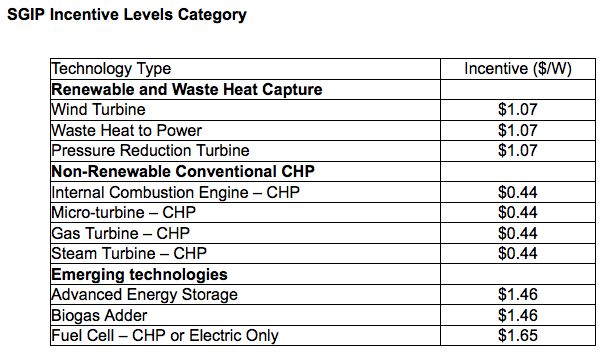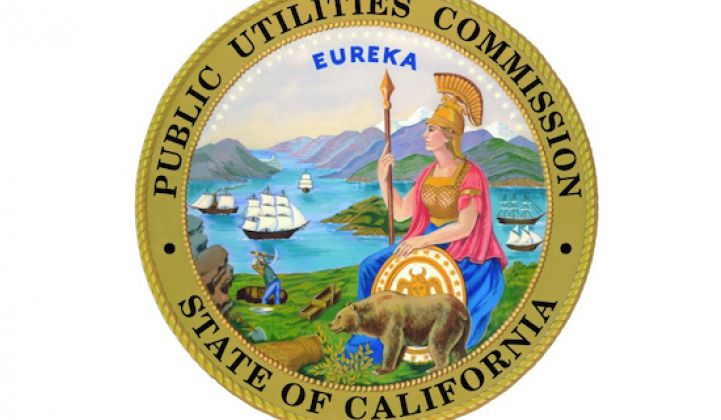Stem, one of the leaders in the emerging behind-the-meter energy storage business, is looking to address some, let's say, irregularities that occurred during a recent big-money offering of renewable energy subsidies in California.
California's $83 million per year Self-Generation Incentive Program (SGIP) provides a generous subsidy to distributed energy resources such as CHP, wind, advanced energy storage and fuel cells. Earlier this year, the CPUC offered about $40 million of the 2016 SGIP total for awards.
As we reported, Stem and one other firm were able to secure the first 56 applications in this solicitation and monopolized the online submission process for the first 2 or 3 minutes of the live opening.
Because of this incident, the CPUC requested that Energy Solutions, the administrator of the “first-come, first-served” applications process, provide a technical analysis of the automated SGIP application launch. Energy Solutions reviewed server and application logs from the day of the program opening to see if applications were submitted in a way that violated the Terms of Usage (TOU) or the SGIP Handbook requirements.
Our earlier article went into the details of the analysis -- a summary is included below.
At that time, Stem aimed to keep the current program results, and noted in a comment to the CPUC, "Stem has provided information regarding its application submission process to Energy Division on a confidential basis, and has offered to provide the Commission with any other information it needs to further confirm the clear explanation and conclusion regarding the February 23 program opening." Stem claims, "Energy Solutions made clear in their presentation that the various techniques used by parties to submit applications were normal and anticipated uses of the Portal as it was designed and not malicious or outside the site’s terms of use."
Stem's CEO poses a resolution
Stem is now suggesting a different solution.
Stem CEO John Carrington has since commented to GTM, "In short, we are volunteering to cancel half of our awarded funds under the program rules from Feb. 23 as long as the CPUC acts in good faith to move the whole program forward as quickly as possible. We hope this enables the industry to move past speculation about the recent submission and get back to building a sustainable market for self-generation projects."
In a letter addressed to the program's administrators, Carrington writes,
Since the February 23rd SGIP opening and subsequent announcement of results, we understand that letters, filings, allegations, and news articles have caused the energy storage community to question every aspect of the SGIP program, and have unfairly created the perception that Stem in some way violated the rules to achieve its level of success.
From day one, we have taken these allegations seriously. We understand that, given the limited funding available to meet the needs of hundreds of customers, the results of this new process were disappointing to several of our peers. Stem has been transparent and cooperative with the Commission, provided materials for review, and requested meetings to present details of our application submission approach.
Stem engaged a comprehensive third-party technology analysis that found no violation of program rules or website terms of use, but because the perception of wrongdoing persists, the surrounding controversy is threatening the opportunity for scores of California businesses, schools and other energy consumers to deploy beneficial self-generation technologies. This controversy is also hindering our efforts to mitigate electric reliability risks with energy storage projects in critical regions of Southern California.
It has therefore become clear to Stem that all stakeholders, especially the California ratepayers, are best served by avoiding lengthy, costly litigation and refocusing everyone on resuming the SGIP program. To this end, as to the applications where Stem is the named manufacturer (including all of the SunPower applications), Stem will voluntarily cancel certain of its reservation request applications such that the retained incentives on projects for which Stem is the manufacturer totals 50% of manufacturer concentration limit published on February 29, 2016 ($17,815,431), after the Commission issues a ruling or order finding that all issues associated with the February 23rd opening are resolved and a formal investigation of the February 23rd opening is unnecessary, and directing the PAs to restart the processing of all applications (including those Stem applications not voluntarily withdrawn). Stem agrees not to pursue its further rights to the cancelled reservations or other claims so long as such Commission action remains final and unchanged and is observed, and Stem is not subject to future comment on these matters by the Program Administrators.
Stem makes this offer not because of any wrongdoing by Stem; rather, Stem views this voluntary reduction as one that will enable the PAs, Stem, the Commission, and other applicants to implement the goals of SGIP most expeditiously: increasing the deployment of distributed generation and energy storage systems, improving the efficiency and reliability of the grid, and reducing greenhouse gas emissions, peak demand, and ratepayer costs.
Stem is a company built on integrity, and we remain committed to serving California customers with resources that also address the needs of the grid. We look forward to continuing to play a productive and collaborative role in the industry.
***
Summary of Energy Solutions' analysis
Energy Solutions arrived at the following conclusions:
- "The application database accepted submissions and assigned timestamps to 658 reservation requests totaling $181 million in requested incentives in the first 10 minutes following program opening at 8:00 a.m. [There were 898 reservation requests on opening day.] Under heavy load, the system responded slowly to user requests, and many system users complained of significant delays in attempting to submit their applications. The timestamps recorded in the database showed that two applicant companies, Stem and SunPower, were successful in submitting and receiving timestamps for 56 total applications in the first two minutes, during which time no other applicant companies in the program completed a successful submission."
- "Stem and SunPower both appear to have been submitting applications from within the Rackspace server network. The selfgenca.com online portal is hosted on Rackspace servers. Stem attempted to submit each of its applications more than once, for an average of 2.37 attempted submissions for each application. This was not unique, as 36 of the 79 applicants attempted to submit at least one application to the system more than once."
Energy Solutions identified three kinds of activity as potentially in violation of policies in the SGIP Program Handbook or the Terms of Use:
- "Three applicants used a POST-only technique to submit applications without using the graphical user interface. This violates two sections of the Terms of Use." [You will not alter, modify, create derivative works of, decompile or otherwise attempt to extract source code from us unless we give you express written permission.] These applicants are Stem, SunPower, and Swell Energy."
- "Many applicants attempted to submit individual applications multiple times. This may be construed as a violation of the Terms of Use, but did not in intent appear to violate the policies in the SGIP Program Handbook relating to submission of duplicate applications." According to the rulebook, "Duplicative applications are considered a program infraction."
- "Some activity appears to indicate the sharing of username and password information among multiple people, although this cannot be proven conclusively. If this were true, this would be a violation of the Terms of Use."
According to the memo:
- "Stem utilized both the POST and the manual methods during the first 10 minutes of program open. With these methods the applicant was able to successfully submit 95 percent of their total 246 applications in the first 10 minutes."
- "For the 233 applications successfully submitted in the first ten minutes, Stem initiated 569 submission requests (389 POST/180 Manual)."
Note: SunPower’s applications under the SGIP program were submitted by Stem, its storage manufacturing partner, on SunPower’s behalf.
- "SunPower utilized the POST method and submitted 100 percent of their 21 applications in the first 10 minutes of program open."
- "For the 21 applications successfully submitted in the first 10 minutes, SunPower initiated 33 POST submission requests and two manual requests, which had an insignificant impact on the outcome for this applicant."
- "Swell Energy attempted to first access the database with the POST method prior to the program opening which failed due to the lock-out (by design). This was the only clear evidence of an attempt to directly access the portal prior to 8 a.m. (Other attempts were to load the homepage or other page of the portal)."
- "Swell then attempted the POST method 807 times for their 81 applications, which failed to successfully submit their applications because they requested the URL incorrectly.
- "Swell then utilized the interface to manually submit their 81 applications, all of which were received after 08:10:00 a.m."
SolarCity has a suggestion
As we have reported previously, SolarCity, along with Avalon Battery, Johnson Controls, Sharp Electronics, Sonnen, and Swell Energy (our honorable mention), has suggested that the funds allocated in the February 23, 2016 solicitation "should not be awarded, and instead the results should be voided and these funds should be rolled into future SGIP solicitations."
SolarCity also noted that the current SGIP structure of "60 percent cost coverage has resulted in reported project costs that are inflated to maximize incentive levels. What is needed is a pricing discovery mechanism that will force SGIP participants to reveal the lowest incentive level necessary to develop projects such that the maximum number of projects can be funded with the limited SGIP budget. Once initial pricing discovery is achieved, the incentive levels should decline over time in a predictable manner to drive cost reductions." More details here.
***
The SGIP is the original California renewables incentive, predating the California Solar Initiative. It was intended "to provide incentives for any distributed generation resources that the commission determines will support the state's goals for reductions of emission of greenhouse gases."

Source: Base SGIP Incentive Levels for Eligible Technologies (from 2015 SGIP Handbook)



